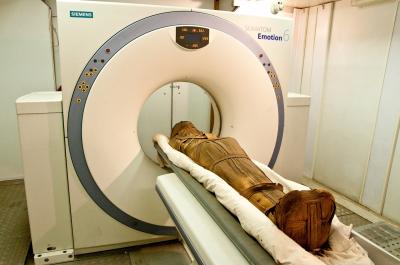 Scientists discoveredthat the ancient Egyptians suffered from – what we often consider to be modern day – heart diseases too. Hardening of the arteries has been detected in Egyptian mummies, some as old as 3,500 years, suggesting that the factors causing heart attack and stroke are not only modern ones; they afflicted ancient people, too.
Scientists discoveredthat the ancient Egyptians suffered from – what we often consider to be modern day – heart diseases too. Hardening of the arteries has been detected in Egyptian mummies, some as old as 3,500 years, suggesting that the factors causing heart attack and stroke are not only modern ones; they afflicted ancient people, too.
“Atherosclerosis is ubiquitous among modern day humans and, despite differences in ancient and modern lifestyles, we found that it was rather common in ancient Egyptians of high socio-economic status living as much as three millennia ago,” says professor of cardiology Dr. Gregory Thomas.
The nameplate of the Pharaoh Merenptah in the Cairo Museum of Egyptian Antiquities reads that, when he died at approximately age 60, he was afflicted with atherosclerosis, arthritis, and dental decay. Intrigued that atherosclerosis may have been widespread among ancient Egyptians, Thomas and a team of U.S. and Egyptian cardiologists, joined by experts in Egyptology and preservation, selected 20 mummies on display and in the basement – yes, it’s filled with artefact, watch the video here – of the Museum of Egyptian Antiquities to go under the CT scan.
The mummies underwent whole body scanning with special attention to the cardiovascular system. The researchers found that 9 of the 16 mummies who had identifiable arteries or hearts left in their bodies after the mummification process had calcification either clearly seen in the wall of the artery or in the path were the artery should have been. Some mummies had calcification in up to 6 different arteries.
Using skeletal analysis – a common non-invasive ‘procedure’ on mummies – the Egyptology and preservationist team was able to estimate the age at death for all the mummies and the names and occupations in the majority. Of the mummies who had died when they were older than 45, 7 of 8 had calcification and thus atherosclerosis while only 2 of 8 of those dying at an earlier age had calcification. Atherosclerosis did not spare women; vascular calcifications were observed in both male and female mummies.
 The most ancient Egyptian afflicted with atherosclerosis was Lady Rai, who lived to an estimated age of 30 to 40 years around 1530 BC and had been the nursemaid to Queen Ahmose Nefertiri. To put this in context, Lady Rai lived about 300 years prior to the time of Moses and 200 prior to King Tut.
The most ancient Egyptian afflicted with atherosclerosis was Lady Rai, who lived to an estimated age of 30 to 40 years around 1530 BC and had been the nursemaid to Queen Ahmose Nefertiri. To put this in context, Lady Rai lived about 300 years prior to the time of Moses and 200 prior to King Tut.
In those mummies whose identities could be determined, all were of high socio economic status, generally serving in the court of the Pharaoh or as priests or priestess. While the diet of any one mummy could not be determined, eating meat in the form of cattle, ducks and geese was not uncommon during these times.
“While we do not know whether atherosclerosis caused the demise of any of the mummies in the study, we can confirm that the disease was present in many,” Thomas says. These new findings suggest that scientists may have to look beyond modern risk factors to fully understand the disease.
The researchers will detail their findings in the November 18 issue of the Journal of the American Medical Association.
To learn more about health and medicine in ancient Egypt, definitely read Paula Veiga’s excellent article ‘Prosthetics, Potions and Prescriptions‘. Prefer the process of mummification over the health issues of the living? Watch Dr. Zahi Hawass explain the recipe, or start small; animal mummies in this video with Dr. Salima Ikram. And did you know the first-ever official mummy autopsy happened almost 200 years ago, but mistakes are easily made.